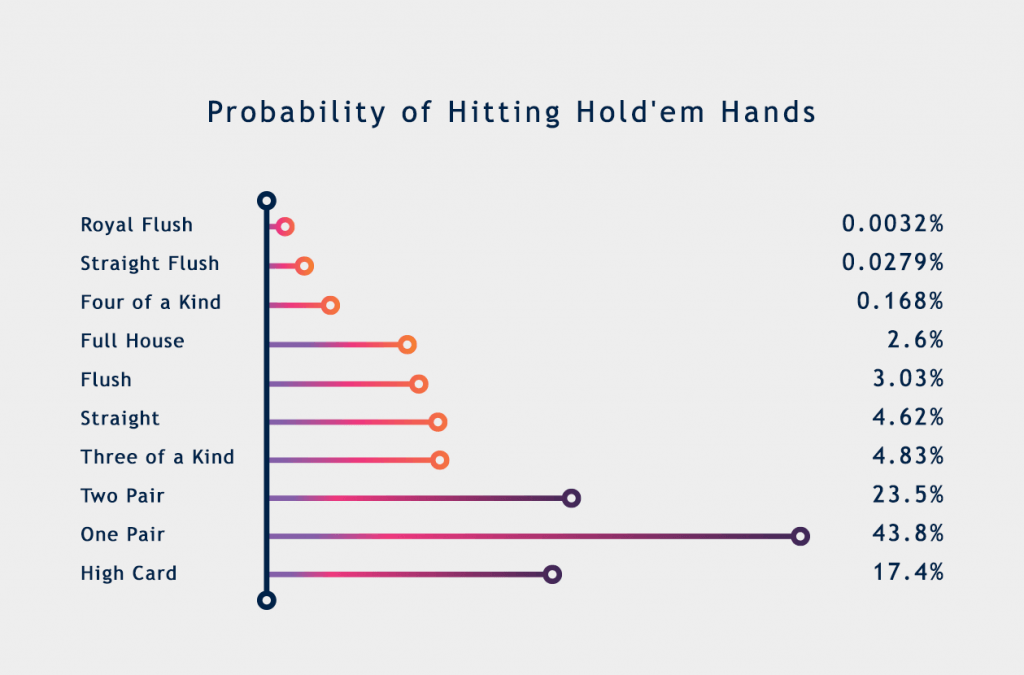Odds Of Winning Hands In Texas Holdem
You can figure out your outs and odds for any hand, but here is a quick and dirty list of the most common scenarios: Texas Hold'em Cheat SheetOdds Based on Outs after the Flop If after the flop, you have: Two outs: Your odds are 11 to 1 (about 8.5 percent) A common scenario would be when you have a pair and you are hoping your pair becomes a three-of-a-kind (a set). Texas Holdem Pre Flop Odds (10 Player Game) This table shows the 169 different hole card combinations (starting hands) in Texas Holdem. The numbers are based on 1.5 billion trials of a ring game (10 players) where everyone calls the blinds then checks to the showdown. Use the odds to your advantage: 1 percent (1-in-100): Percentage of time that no player holds an Ace or a King at a table in a 10-handed game. 1 percent (1-in-100): Percentage of time that if you hold two suited cards, you’ll flop a flush. 6 percent (about 1-in-20): Percentage of time that five community cards will give pocket suited cards a flush. Pocket pairs are a favourite type hand for many players. Pocket pairs from 22 right up to AA can be played profitably with the right strategy, even if hands like AA and KK are a lot more exciting to play. Use the pocket pairs table below to find out the odds of being dealt different ranges of pocket pairs during a game of Texas Holdem. How To: Bluff in a Texas Hold 'em poker game How To: Count odds and outs in Texas Hold'em poker How To: Play Texas Hold'em How To: Play after the river in no limit Texas Hold'em How To: Determine chance of winning a hand in Texas Hold'em.
Both before and after the flop in any limit Holdem game, it is helpful to be able to make a reasonably accurate estimate of the types and numbers of playable hands that you are likely to be competing against.
Much of your decision making involves the business of 'putting' opposing players 'on their hands' (or in other words, figuring out what cards they are playing). Experienced Holdem players are often very good at this. An understanding of the types of hands that are most likely to be against you helps prevent both underestimating and overestimating your competition.
Here are some stats that are based on the total possible combinations of various Holdem hole cards that are normally playable.
For better viewing on your mobile device (or to download or print the chart), check out holdem hole card frequencies in high resolution universal .pdf format.
The five different types of two card Hold'em hands highlighted here are those that are most commonly played. They are not shown in any particular order and within the groups are powerful hands that are almost always played, down to marginal value hands that can be played under certain betting conditions.
The rest of the hands, shown as All Others, are all the very weak hands that most players hardly ever play.
Pairs - All pairs. AA, KK, QQ, JJ, 1010, 99, 88, 77, 66, 55, 44, 33, 22

Odds Of Winning Hands In Texas Hold'em
Two High Cards Suited - AK(S), AQ(S), AJ(S), A10(S), KQ(S), KJ(S), K10(S), QJ(S), Q10(S), J10(S)
Two High Cards Unsuited - AK, AQ, AJ, A10, KQ, KJ, K10, QJ, Q10, J10
Odds Of Each Hand In Texas Holdem
Medium and Low Suited Connectors - These include both no-gap and one-gap connectors: J9(S), 109(S), 108(S), 98(S), 97(S), 87(S), 86(S), 76(S), 75(S), 65(S), 64(S), 54(S), 53(S)
Probability Of Winning Hands In Texas Holdem
Ace and Non-High Combinations - A9, A8, A7,A6 Note: 25% of these 64 combinations (16) are suited. 75% of the 64 combinations (48) are unsuited.